Nerd Alert: This post teaches you How to use a kitchen food scale to count Calories & Macros in Indian Food. This method takes time but is 100% more reliable than using automated methods like using apps or websites.
What is a kitchen food scale?
It is a kitchen instrument used to measure the weight of food or food ingredients. It is compact and lightweight. The measurement by a scale is more accurate than measurement by volume. They are available in balance, spring, and digital models. The digital model is the most preferred due to its precision and easy care.
What are the other popular names for a food scale?
There are many popular names for a food scale. The most popular ones are:
- Kitchen Scale
- Kitchen Weighing Scale
- Food Measuring Scale
Why use a food scale?
Using a kitchen food scale to count calories and track macros gives precision. As the famous saying goes, “What gets measured gets improved.”
Smart healthy eating is a skill. Like most skills, we need training wheels in the beginning. The kitchen food scale is the training wheel for healthy-eating. Often we base our idea of what is healthy on guesswork or on conflicting knowledge gathered from different sources. Using a food scale will give us clarity, which in turn will make us confident with our food choices.
Is using a food scale to measure calories and track macros in Indian food tedious? Yes, it is. In my opinion, it is so because it is too simple and hence not challenging at all. Moreover, we have to do it every time we prepare a new recipe. So you may ask, isn’t their a workaround. Of course, there is. We can use an app like MyFitnessPal or any website to achieve the same result. However, I strongly suggest avoiding them at the beginning primarily for the following reasons:
- Using a food scale is a manual process of counting calories compared to using an app or website, which is an automated process. Compare it to writing vs typing. According to a research, writing has a cognitive edge over typing. Manual and automated processes engage different areas of your brain, though they may be achieving the same result. E.g., we may take notes either by writing or by typing. In my experience, when I use a food scale to count my calories and track macros I better understand the nutrition process than using an app.
- Manually measuring calories gives us a perspective and a psychological shift. We tend to look at food differently. It is one thing to say that a 1 tablespoon of butter is 80 calories and it is another thing to visually see the process in action. Compare it to paying money digitally vs paying in cash. Paying in cash makes us more conscious. Similarly, when we see the food for their actual calories we become more conscious of how we consume them. We become liberal and conservative automatically with different foods without using any will power. And this is a great power to have.
I hope I’ve been able to convince you to use a food scale. If not, then I’m relying on the title of this article and assume you are already convinced to use one 😉 In that case, I apologize for taking your time but I hope I’ve strengthened your conviction in a food scale. I’ve lost 32 Kg by just using the food scale and hence swear by it. Please do try it.
Benefits of Kitchen Food Scale:
-
- They help with portion control
- They make you more aware and conscious of serving sizes. Knowing the correct serving size will help you to manage calories more effectively.
- They help with counting calories and tracking nutrition. By knowing the correct weight of a food item, you’ll be aware of its calorie and nutrition content. It takes out the guesswork, which in my opinion is the most powerful reason for unhealthy eating.
- They help with measuring hard to weigh ingredients. Measuring 1 teaspoon of any item will be difficult on a normal scale. A kitchen weighing scale is designed with measuring small sizes in mind.
- It is a training wheel for developing a healthy-eating habit
Types of food scales
Balance Scale
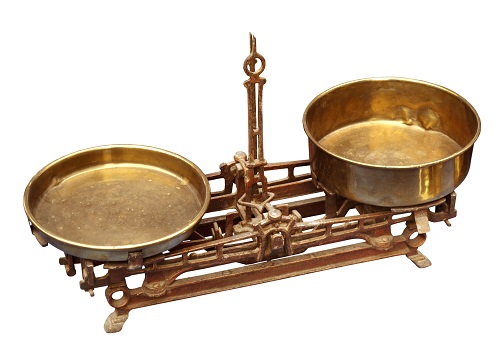
Balance Kitchen Scale
This is your old school type scale. It does the measurement by comparing your food item to a known weight. Use it if you are just feeling nostalgic or if the measurement is not your concern 😉
Mechanical Scale
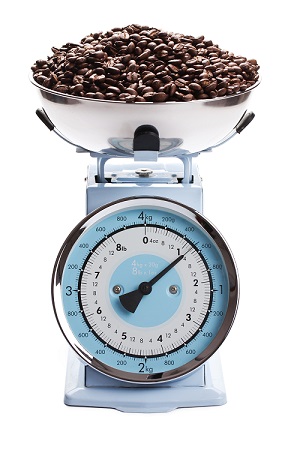
Mechanical kitchen food scale
It uses a spring to measure the weight of your food item. The spring technology is poor at handling smaller weights. And our home cooking is going to deal with small weights and I mean really small weights. Also, the spring undergoes wear and tear much faster and hence can become unreliable. For the aforementioned reasons, we can avoid using a mechanical scale for home cooking.
Digital Scale
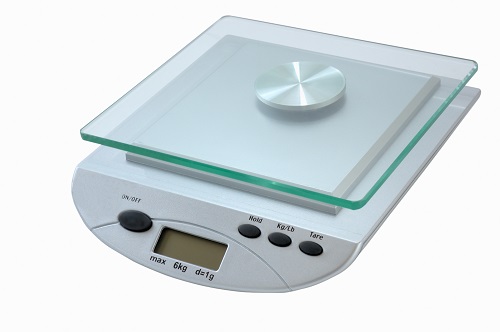
digital kitchen scale
It uses electrical components and a simple computer to measure the weight of your food item. They are widely available for all kinds of budgets.
How to use a Kitchen Food Scale to count Calories & Macros in Indian Food?
Watch the video to better understand the process of using a Kitchen Food Scale and using it to count calories and track macros.
As explained above, we can use different types of scales for food measurement. I prefer the digital scale for 2 reasons:
- Precision
- Easy Maintenance
Before you begin using your scale, please read the user manual/instructions provided with your scale. Some scales may have additional features like storing and displaying calorie measurements and nutritional value. They also provide instructions on care and maintenance.
The steps explained below pertain to a digital scale. They are generic steps and apply to all types of digital scales. As mentioned earlier, please refer to your scale’s user manual for specific features.
Instructions
- Place the scale on flat and hard surface
- Switch on your scale using the power button
- Check the initial reading shows zero
- Select the unit of measurement .e.g. gm or oz
- Place a container in which you’ll place food items for measurement
- After placing the container set the reading back to zero using the tare button. Please read your user manual if it is done differently on your scale.
- The scale (with the container) is now ready for use
- After measuring your food clean the scale
- Turn off the scale and place it safely for future use
Additional use of tare button:
The function of the tare button is to reset the scale reading to zero. Hence we can also use it to measure multiple food items without changing the container. Also, if we are using different size containers then we can reset the reading to zero each time we change the container.
Points to remember:
- It is a precision instrument hence handle it very carefully
- Never drop it and avoid shocks to it
- Never overload it. Check your user manual for the maximum capacity of your scale
- Place the food item to weigh in the middle of the scale to ensure the greatest accuracy
- Never allow your scale to be saturated with water, as this will damage the electronics
- Don’t use strong or hard chemicals to clean the scale. Please clean the scale with plain water (and a mild detergent if needed.)
- Never store the scale in an upright position when not in use as it will drain the batteries
- Remove the batteries if you don’t intend to use the scale for a long time
How to Calculate Calories in Indian food using a Kitchen Food Scale?
Nerd Alert! I am a big fan of doing things manually. Call me a paranoid, a freak, or just a fellow who enjoys having control over his tasks. The process of counting calories that I have explained below is tedious. But with a little practice, you’ll find it quite easy.
Please allow me to digress here. I want to use technology to its minimum. Technology helps us save time and there is absolutely no doubt about it. But what do we really do we that extra time? Mostly we use it unproductively. Doing things manually gives me the feeling of digital detox and that of off-grid living.
First learning to do things manually and then using technology to automate things that are indeed monotonous helps me to use technology consciously. Just my 2 cents there. You may take it or leave it. Also, I apologize for taking your time if you intended to learn the process of using the food scale to count calories and track macros in another way. And if you agree with my thought process then continue and I promise I won’t disappoint you. Once you have the manual control over the healthy-eating skill it is a life skill that you’ll always appreciate having.
Back to the point of this article 😉
The simplest way to count calories in food is to calculate the calories in each individual ingredient used to prepare it. I am using “food” in a generic way. Sometimes food may contain just one item e.g. a banana or it may contain multiple items e.g. mixed fruit salad. In either case, note down the ingredient/s and calculate the calories in them.
Steps to calculate the calories in Indian food using a kitchen food scale:
- Take a recipe
- List all the ingredients as per the recipe
- Measure the weight of each ingredient using a kitchen food scale
- Once we the have the weight of each ingredient we’ll use Google to calculate the calories
- After we have the calories of all the ingredients, we then just sum them up and voila we have the calories in the entire recipe
Use Google to measure the calories in the individual food ingredient
Type the following in Google: “Food ingredient” Calories
e.g. Chicken Calories or Milk Calories or Cabbage Calories etc.
And Google would show you the calories contained in it per 100 grams.
Example 1: Finding the calories in Cabbage
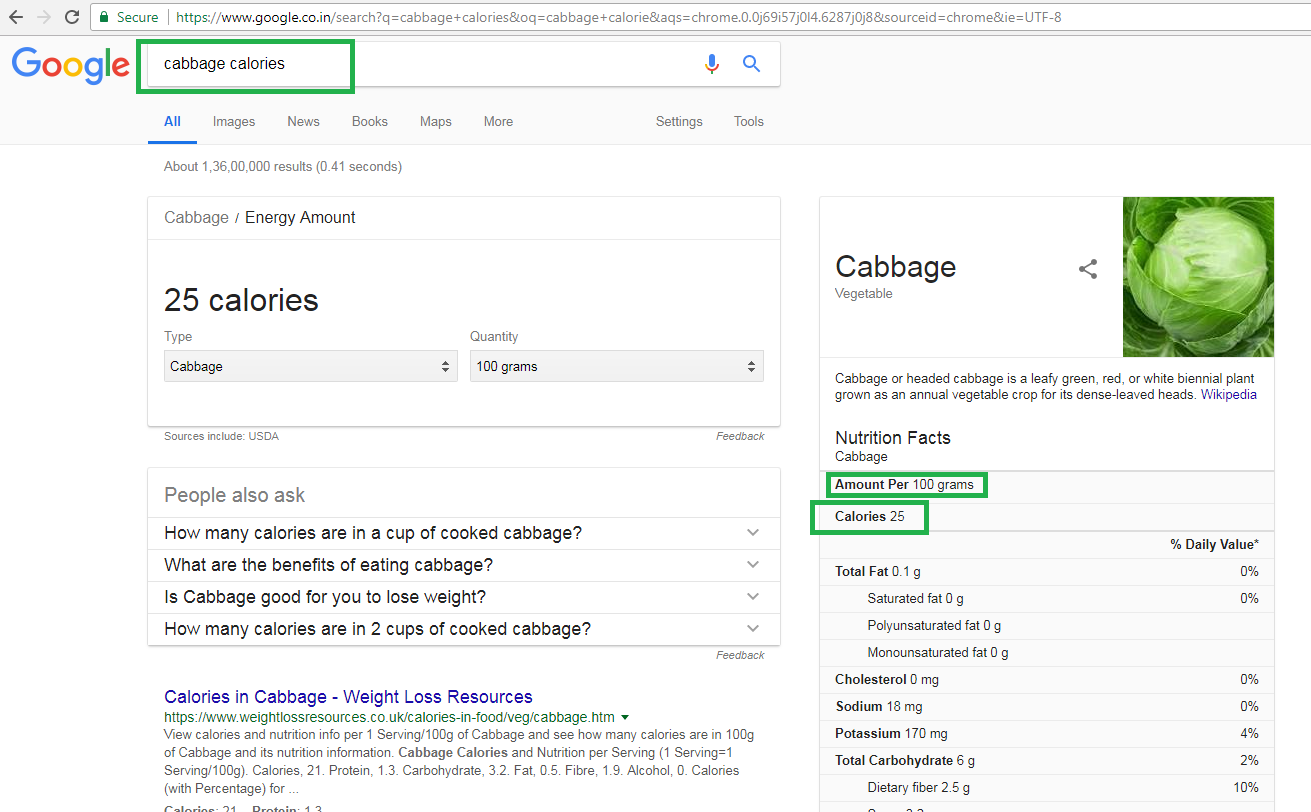
Example 2: Finding the calories in Chicken
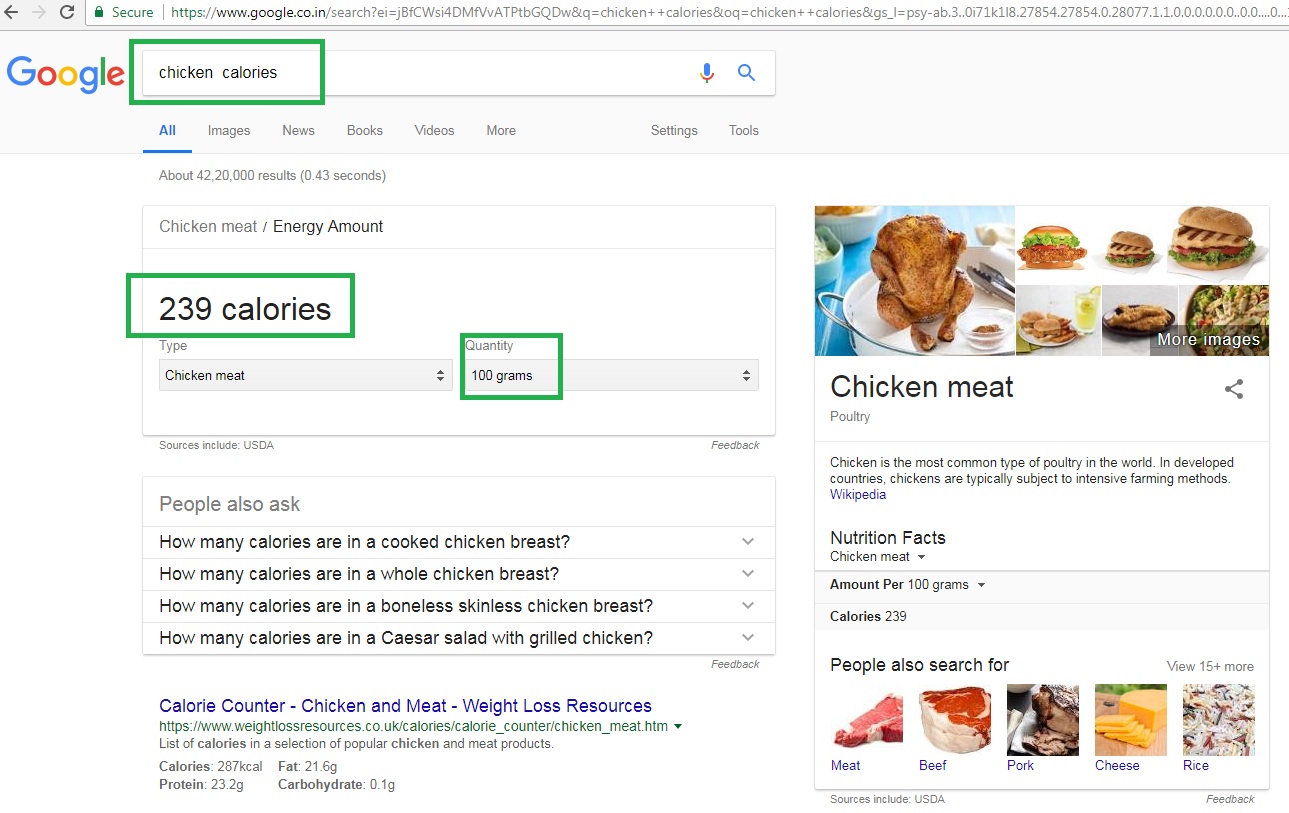
Avoid searches like “Dish_Name/Recipe_Name” Calories
e.g. Roasted Chicken Calories or Green Salad Calories or Pasta Calories or Tea Calories or Chicken Tandoori Calories etc. Always search for the calories of individual ingredients and not the whole recipe.
Once we have the calories per 100 gram or any other equivalent we can then find the calories in our ingredient.
Let’s do the math. And you thought, Math got over with school 😉
Say we are preparing a vegetable soup. One of the ingredients used in it is cabbage.
- First, we calculate the weight of cabbage using the food scale (say we get 50 gm)
- Next, we find the calories in cabbage using google (100 gm = 25 calories)
- Hence the calories in the cabbage as per our recipe is .25*50 = 12.5 calories
Example
Calculate the calories in Roasted Chicken.
List the Ingredients:
- 1 Chicken breast
- 1 cup Curd
- 2-4 Celery
- 1 tbsp Olive oil
Weight of each ingredient:
- Chicken breast – 500 gm
- Curd – 100 gm
- Celery – 100 gm
- Olive oil – 15 gm
Calories in each ingredient:
- 500 grams Chicken – 1195 calories. ( From google: 100 grams = 239 calories)
- 100 gm Curd – 98 calories (From google: 100 grams – 98 calories)
- 100 gm celery – 160 calorie (From google: 100 grams = 16 calories)
- 15 gm olive oil – 133 calories ( 100 grams olive oil = 884 calories)
Total Calories: 1586 calories
Calculate the calories in Tea (with milk)
- 2 cups of water: 0 calories
- 100 grams of milk: 42 calories
- 5 grams (1 tsp) tea powder: 0.01 calories. (100 grams = calories; 1 tsp = 5 grams)
- 20 grams (4 tsp) sugar: 38 calories. (100 grams = 387 calories; 1 tsp = 5 grams, 4 tsp = 20 grams)
- 10 grams (2 tsp) crushed ginger: 8 calories. (100 grams = 80 calories; 1 tsp = 5 grams, 2 tsp = 10 grams)
Total Calories: 88 calories.
How to Calculate Macros in Indian food using a Kitchen Food Scale?
Macronutrients (Carbohydrates, Fats & Proteins) are required in large quantities by our body and they provide the bulk of our energy requirements.
The process of calculating Macros is the same as calculating the calories that I explained earlier. Just remember these magic numbers:
- 1 gm Carbohydrate = 4 calories
- 1 gm Protein = 4 calories
- 1 gm Fat = 9 calories
The way we fetched the calorie info using Google the same way fetch the Macro info. Instead of calories, we note the Carbohydrate, Protein & Fat info.
Steps to calculate the Macros in Indian food using a kitchen food scale:
- Take a recipe
- List the ingredients in the recipe
- Measure the weight of each ingredient using a kitchen food scale
- Once we the have the weight of each ingredient we’ll use Google to calculate the macros
- After we have the macro info of all the ingredients, we then just sum them up and voila we have the macro content of the entire recipe
Use Google to measure the Macros in the individual food ingredient
Go ahead and type the following in Google: “Food ingredient” Calories
e.g. Cabbage Calories
And Google would show you the calories and macro info contained in it per 100 grams.
Example: Finding the Macro content in Cabbage

Again let’s go to the Math class 😉
Say we are preparing a vegetable soup. One of the ingredients used in it is cabbage.
- First, we calculate the weight of cabbage using the food scale (say we get 50 gm)
- Next, we find the Macro content in cabbage using google
Per 100 gm
-
- Carbohydrate = 6 gm
- Protein = 1.3 gm
- Fat = 0.1 gm
- Hence the Macro content in the cabbage as per our recipe is
- Carbohydrate = 0.06 * 50 = 3 gm
- Protein = 0.013 * 50 = 0.65 gm
- Fat = 0.001 * 50 = 0.05 gm
- Also, the calories from Macros would be
- Carbohydrate = 3 *4 = 12 calories (1 gm Carbohydrate = 4 calories)
- Protein = 0.65 * 4 = 2.6 calorie (1 gm Protein = 4 calories)
- Fat = 0.05 * 9 = 0.45 calories (1 gm Fat = 9 calories)
Example:
Calculate the Calorie and Macros in Vegetable Egg Soup
Take the recipe and List the ingredients in it
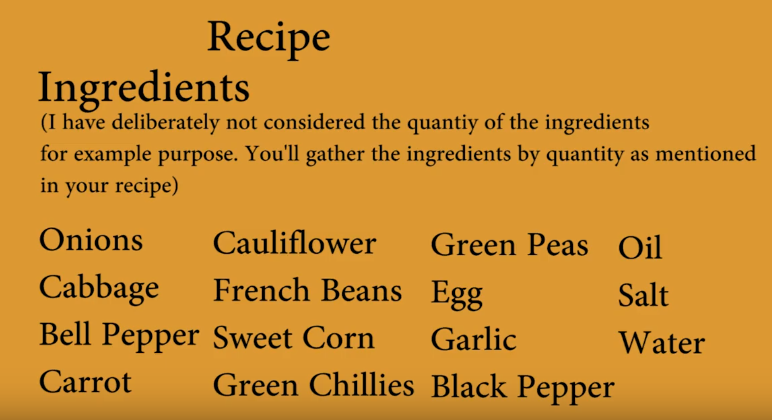
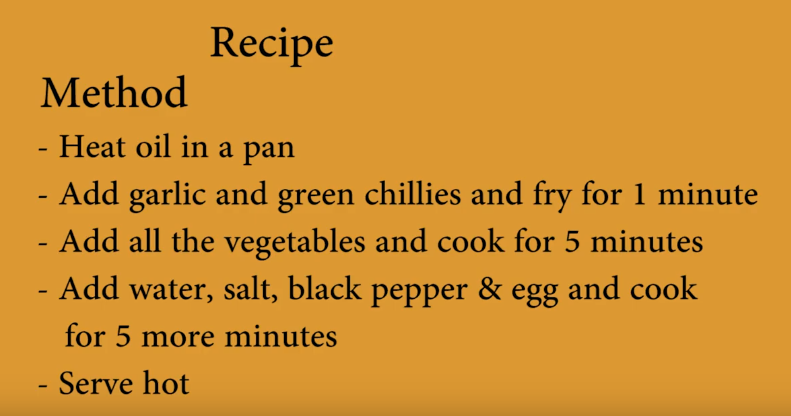
Find the calorie and macro info of each ingredient using Google
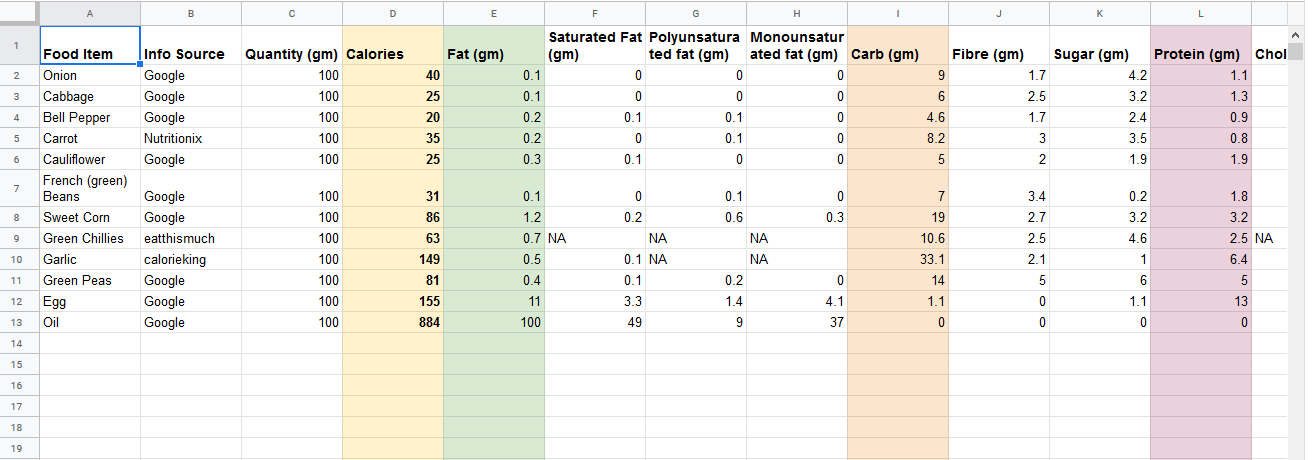
Measure the weight of each ingredient using a kitchen food scale. Once we have the weight of each ingredient we’ll use Google to calculate the macros. After we have the macro info of all the ingredients, we then just sum them up and voila we have the macro content of the entire recipe
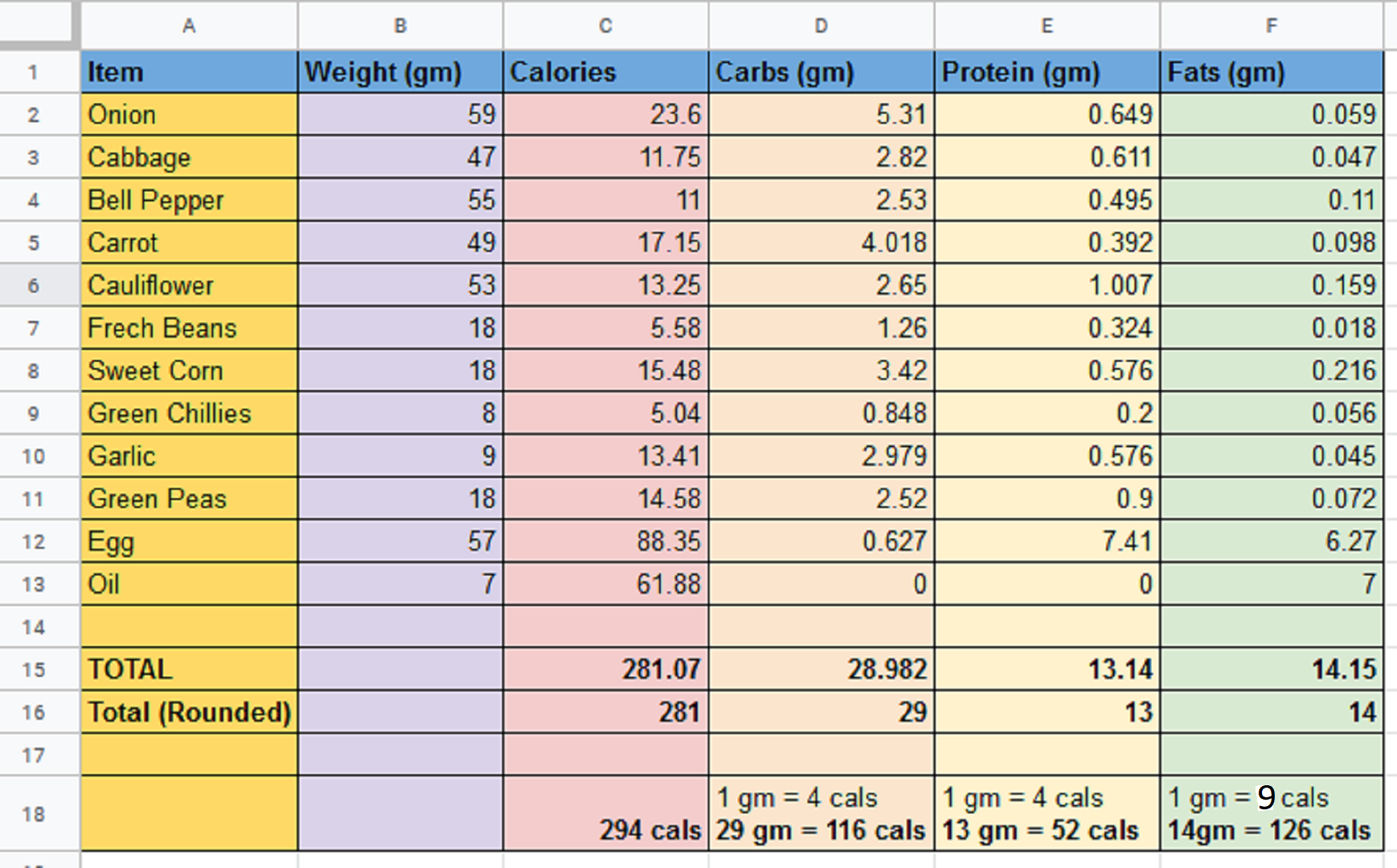
I hope you found this post useful. I am aware that it is geeky. But then I’ve intentionally kept it that way. When I began my weight loss journey I was bombarded with info. Most of it was repetitive in nature and hence very ambiguous. After a lot of reading around, I was finally able to understand how to count calories and macros. Then I did the most important thing, I implemented what I learned 😉 And I achieved my goal.
I wanted to share the exact method that I followed. Hence, what you read above is what exactly I did. It was very tedious in the beginning. But since it was so transparent I felt confident about my effort. Had I not achieved success with it I would have never shared it.
I know it is not for everyone. Folks who have an analytical bent of mind would appreciate it more. Nevertheless, try it!
Also, if you are interested in learning healthy-eating as a skill then please visit my Free Smart Healthy-Eating Program. Psst! Equally Effective for Weight Loss
Thank you for reading. Please let me know your views in the comments below.
References:
- http://www.cookingforengineers.com/article/82/Kitchen-Scales
- https://www.livestrong.com/article/248991-how-to-use-a-food-scale/
Disclaimer:
